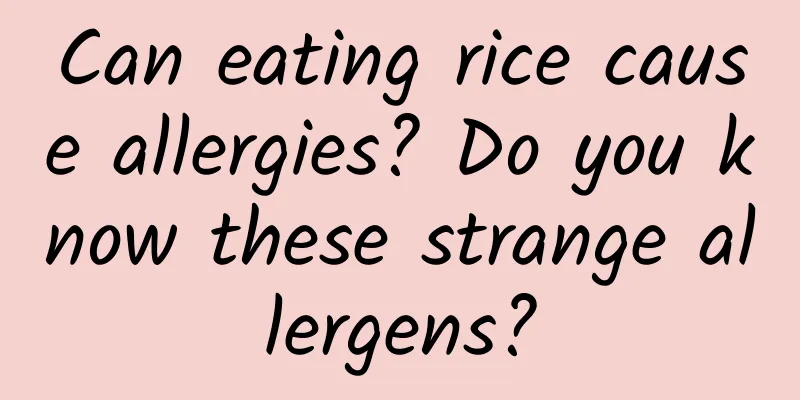Can eating rice cause allergies? Do you know these strange allergens?

|
recently Artist Guo Biting revealed her troubles with skin allergies in a variety show When I revealed that I had severe allergies during puberty Acne on the face and ulcers in the mouth Finally, I went to the hospital for examination and found The allergen turned out to be rice! (Screenshot from the show) The topic became a hot search as soon as it came out This has sparked discussion among many netizens: Is there anyone who is allergic to rice? In this regard, some netizens expressed their own opinions: Rice allergies are not uncommon In addition to rice “What outrageous allergens have you come across?” The comments from netizens were eye-opening: Why does rice cause allergies? Are food allergies and food intolerances the same thing? Which foods are most likely to cause allergies? How to diagnose and prevent food allergies? Come and have a look↓ Rice allergy is not an isolated case Allergic to fish, shrimp, mango, eggs, etc. Nothing new But who would have thought Rice, which is an indispensable food in almost every meal, may also cause allergies? Although rice is not a common allergen But cases of rice allergies are not uncommon. Rice Allergy Case Report Case 1: In 2022, the media reported that a 2-year-old girl in Jilin had a long-term cough after she was weaned from breastfeeding. She went to the doctor and took medicine for half a year but still could not recover. "The child saw the fifth doctor before he asked for an allergy test. The first level of allergen classification includes rice, wheat, etc. " Case 2: In 2023, the media reported that Mr. Wu, who worked in Shanghai, had been troubled by diarrhea for many years . He had tried drugs to adjust the intestinal flora and regulate immune function, but his symptoms did not improve. At the doctor's suggestion, he took a test called "food allergen screening", and the result shocked him and his family - rice allergy! Food allergy is an overprotective immune response of the human immune system to certain foods that enter the body. Allergy to rice may be due to the production of IgE antibodies against specific proteins in rice in the body of the eater. When these proteins are ingested again, mast cells will release mediators such as histamine, triggering an allergic reaction. In addition, food allergies can be roughly divided into two categories according to different pathogenesis, and the symptoms are also different: IgE-mediated food allergies are usually immediate That is, allergic symptoms appear within 1-2 hours after eating, which may involve multiple organ systems. Typical symptoms include skin wheals, edema, vomiting, abdominal pain, wheezing, and even syncope and shock. Non-IgE-mediated food allergies are usually delayed That is, allergic symptoms appear several hours to days after eating. This type of allergic disease mostly occurs in infants and young children, and the main clinical symptoms are concentrated in the gastrointestinal tract. Food allergy ≠ food intolerance If you suspect you are allergic to a certain food, the most reliable way is to go to the hospital and have a doctor diagnose you. What symptoms should make you suspect or be highly alert to possible allergies? Refer to the following chart: (Chart source: Department of Allergy, the Third Affiliated Hospital of Sun Yat-sen University) The diagnosis and severity of acute food allergies need to be confirmed by a professional physician based on the patient's symptoms, medical history and relevant laboratory tests, and anti-allergic drugs such as antihistamines, mast cell stabilizers, oral or topical corticosteroids, epinephrine, etc. should be used as prescribed by the doctor. It is worth mentioning that people easily confuse food allergies with other types of adverse food reactions, so that they often attribute various discomfort symptoms after eating, such as abdominal bloating, abdominal pain, acid reflux, palpitations, headaches, etc., to food allergies. But in real life, a large proportion of them are not true food allergies. In medicine, adverse food reactions that do not involve the immune system and are usually not caused by food proteins are called food intolerance . Attention! Food allergy and food intolerance are not the same thing: Food allergy is generally mediated by IgE and is a type I allergic reaction. It is characterized by rapid onset, usually not directly related to the intake of specific foods, and allergic symptoms can occur with a small amount, and symptoms are quickly relieved after drug treatment. Food intolerance is mediated by IgG and is a type III allergic reaction. It is characterized by delayed onset, which can occur hours or days after eating. It is quantitatively dependent and cumulative with the intake of specific foods. Generally, the more you eat, the more obvious the symptoms. Food intolerance can be managed and the patient's symptoms can be relieved through food diaries, elimination diets, and alternative choices. Source of chart: The First Affiliated Hospital of Guangzhou University of Chinese Medicine Which foods are most likely to cause allergies? When it comes to allergies, what foods do you think of first? Fruits? Eggs? Or seafood? There are many more types of food allergens than you think! As of April 2022, the official website of the Allergen Nomenclature Section of the International Union of Immunology has recognized as many as 401 food allergens. Among them, common key food allergens abroad include: gluten-containing grains, crustaceans, eggs, fish, milk, peanuts, soy beans and tree nuts. What are the differences in the most common allergenic foods among Chinese residents? In August 2022, the "China CDC Weekly (English)" published five research papers on food allergies. One of the studies was a multicenter cross-sectional epidemiological survey conducted in Jiangxi Province in 2020. The eight most common allergenic foods were shrimp, mango, shellfish, eggs, fish, beef, milk and mutton in descending order, with prevalence rates of 1.95%, 1.22%, 1.07%, 0.68%, 0.49%, 0.35%, 0.34% and 0.25%, respectively. (Source: Methods and Applications: A Methodology of Epidemiologic Study in the General Population Focusing on Food Allergy — China, 2020. Chart translation: Gu Zhongyi Studio) Another meta-analysis of 24 cross-sectional studies on the epidemiology of food allergy in China from 2000 to 2021 based on multiple databases pointed out that according to different food categories, 27% of allergic people in China are allergic to crabs and eggs, 22% are allergic to milk, 19% are allergic to shellfish, 16% are allergic to shrimps, 16% of patients are allergic to fruits (mangoes account for 15%), and 15% are allergic to fish. The conclusions of the two studies are generally consistent. Compare and see if you are one of the people with food allergies mentioned above? Source: Youth Shanghai, Guangzhou Daily, Health Appointment, Public Health Magazine, Healthy China, Wenhui Daily |
>>: Sea otters: Not only cute, but also clean marine forest heroes
Recommend
Two major channels for Tik Tok to get free traffic!
There is always not enough traffic for the video,...
Self-driving cars will make this billion-dollar market extinct
According to foreign media reports, in an intervi...
Example sharing: Innovative growth strategies of 12 top teams including Facebook, Airbnb, etc.
The original article lists 21 innovative growth e...
Why doesn't anyone like your ad?
I have been thinking about a question recently. I...
Qunar Mobile APP Product Analysis Report
According to iResearch Consulting Group’s monitor...
Is it difficult to make a small program yourself? Is it difficult to make your own mini-program?
Is it difficult to make a small program yourself?...
5 tips to help you effectively increase APP downloads!
When it comes to the number of APP downloads, tho...
China Passenger Car Association: Global auto sales to reach 89.18 million units in 2023, up 11% year-on-year
Cui Dongshu, secretary general of the China Passe...
The current situation, pain points and suggestions for brand social media operations
After researching nearly 20 brands’ social media ...
Short video operation | How to increase the purchase rate?
One of the most important purposes for companies ...
Operations: Where is the entry point to find accurate users? ?
one. Definition and classification of users 1. De...
The embarrassment of Apple and Xiaomi’s “softening”: Internet service revenue has been slow to rise
Can the Internet business be the savior of mobile...
Which computer rooms have the best cost-effectiveness for hosting servers?
With the rapid development of the Internet, more ...
Evolution and disruptive innovation of the 5G private network market: Q1 2022
Participants take partnerships and strategy more ...









